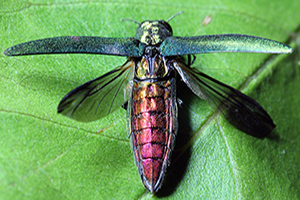Photo Credit: David Cappaert, Bugwood.org. Creative Commons Attribution-Noncommercial 3.0 United States (CC BY-NC 3.0 US) License; https://creativecommons.org/licenses/by-nc/3.0/us/.
Agrilus planipennis
Common Name: emerald ash borer
Animal Guild: Insect
Class > Order > Family: Insecta > Coleoptera > Buprestidae
